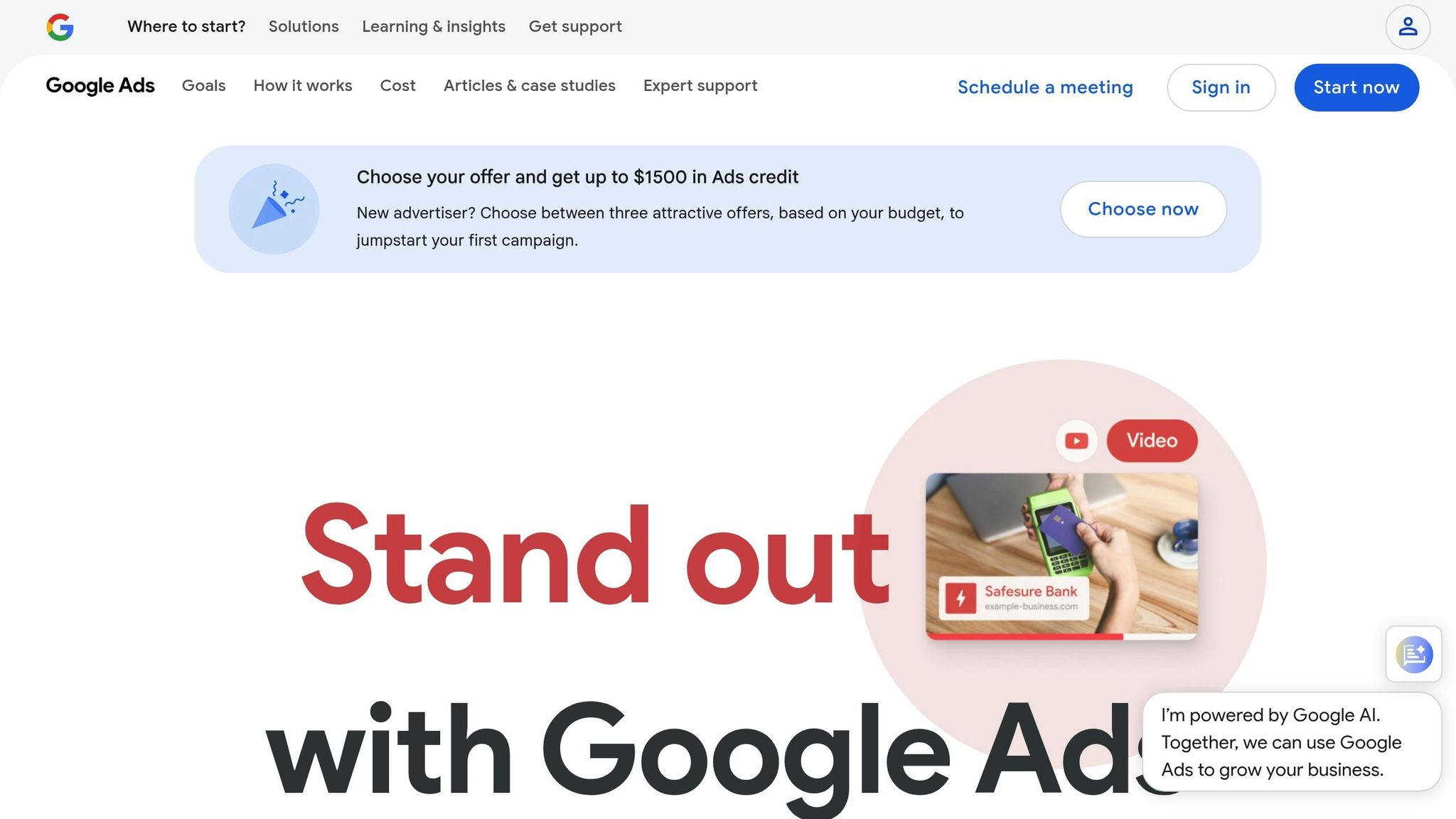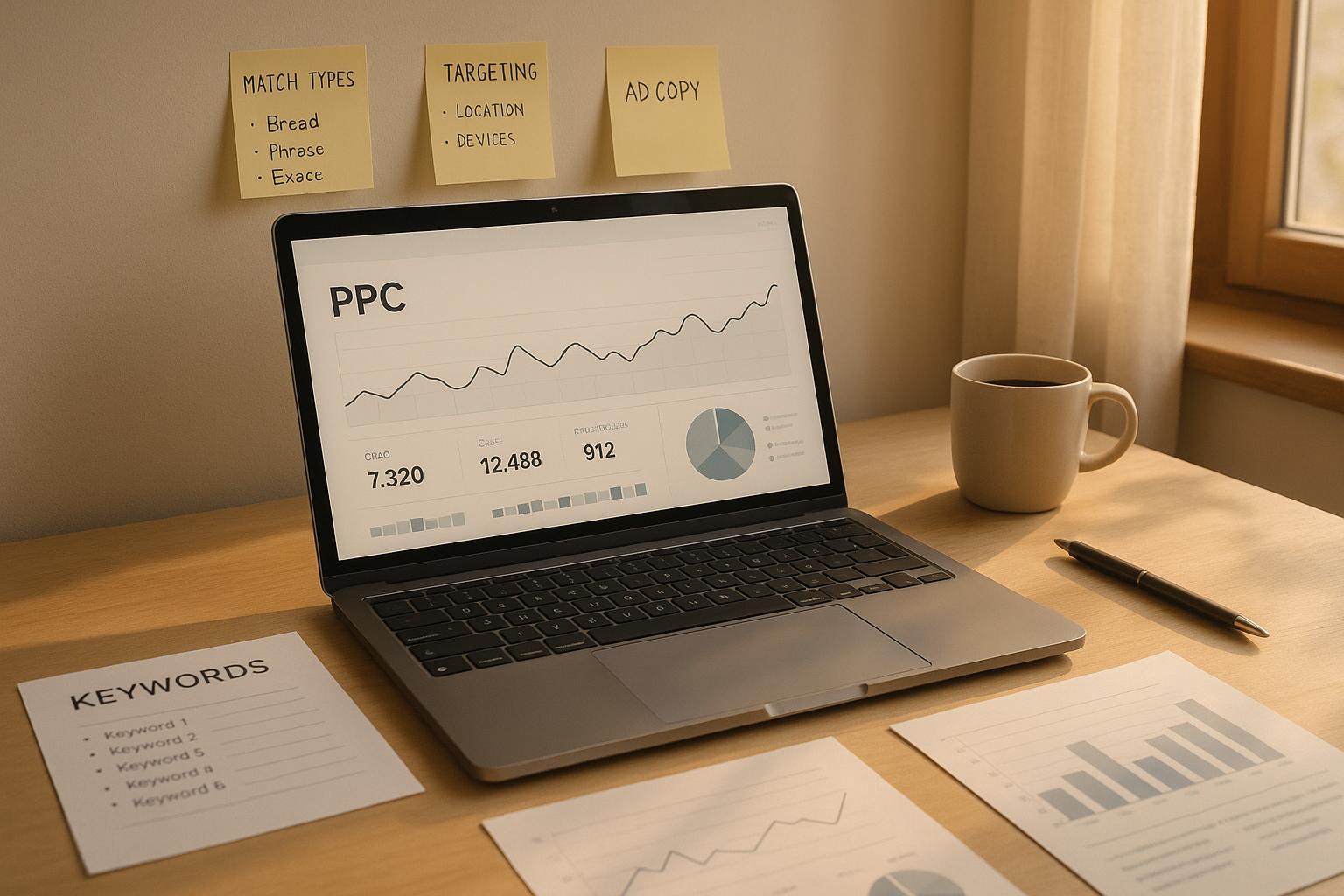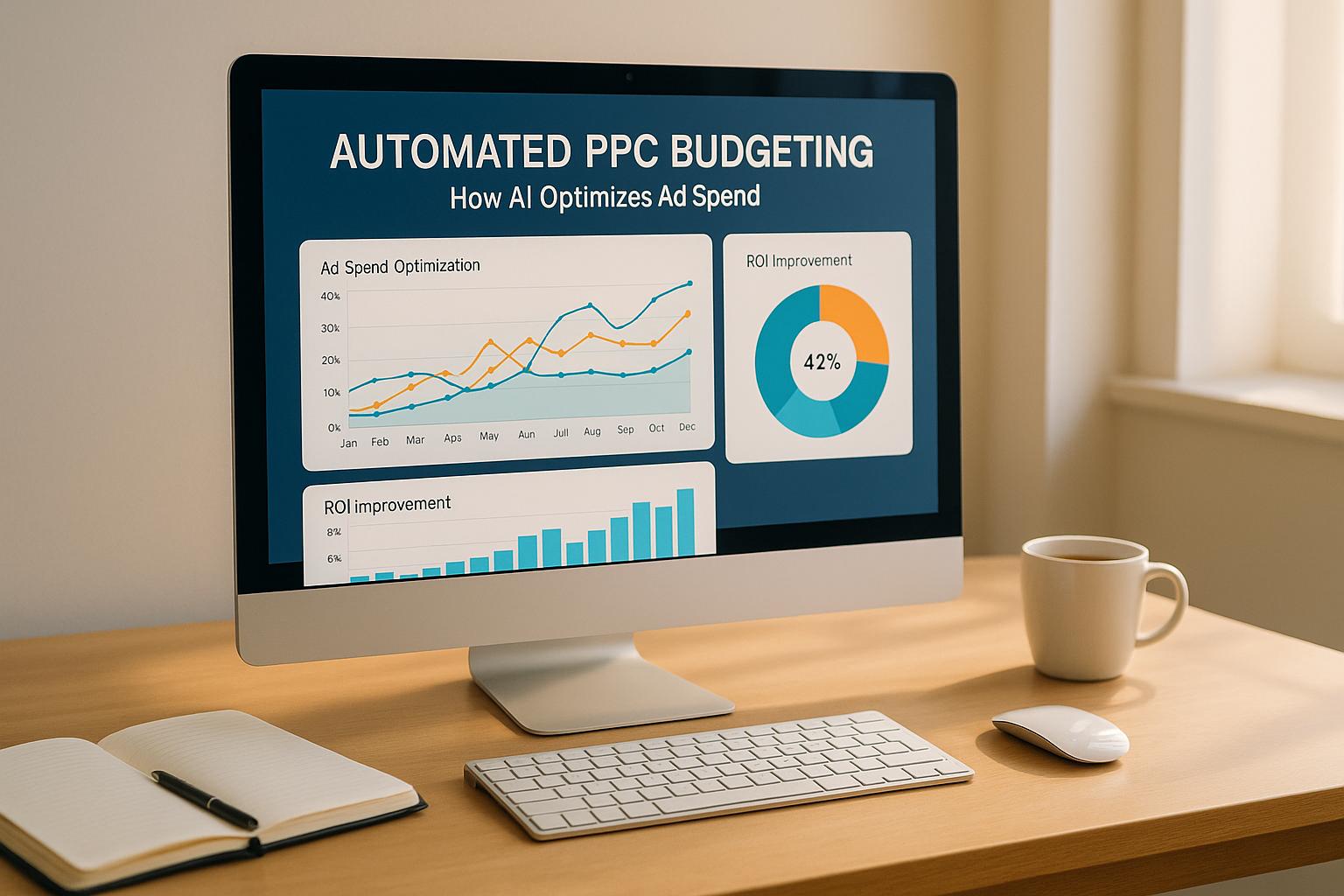Want to improve your PPC results? Start by analyzing your competitors' bidding strategies. Here's a quick breakdown of how to do it:
- Use tools like Google Ads Auction Insights, Semrush, and SpyFu to monitor keywords, impression share, and historical trends.
- Track key metrics such as CTR, conversion rate, CPC, and ROAS to gauge competitor performance.
- Study competitor ad copy for messaging priorities, emotional appeals, and CTAs.
- Analyze their landing pages for conversion paths and message alignment.
- Adjust your bidding strategy based on gaps in competitor activity, such as targeting less competitive times or keywords.
Pro Tip: Combine daily insights from Auction Insights with weekly and monthly reviews using platforms like Semrush and SpyFu for a complete picture. This approach helps you refine your strategy, reduce wasted spend, and maximize ROI.
Quick Overview:
- Tools: Google Ads Auction Insights, Semrush, SpyFu, Ahrefs
- Metrics to Watch: CTR, CPC, ROAS, impression share
- Key Actions: Monitor bidding patterns, analyze ad copy, review landing pages, optimize budget allocation
Now let’s dive deeper into these strategies and tools to help you stay ahead in the competitive PPC landscape.
Google Ads Auction Insights: How Your Ads are Performing Compared to Your Competitors

Using Auction Insights to Find Competitors
Google Ads Auction Insights is a handy tool that shows you exactly who’s competing for the same keywords as you. It offers a real-time snapshot of the advertisers bidding in the same auctions, making it a valuable resource for spotting competitors. By understanding Auction Insights, you can track bidding patterns and make smarter decisions about how to allocate your budget.
To access this tool, log into your Google Ads account, choose the campaign or ad group you’re interested in, and click on "Auction insights." Use the filter icon above the statistics table to narrow down the data to specific keywords or ad groups. This report is available for Search, Shopping, and Performance Max campaigns, as long as they meet Google’s minimum activity requirements.
Key Metrics to Watch
Auction Insights provides several metrics to help you understand your competitive standing:
- Impression Share: The percentage of total available impressions each competitor captures.
- Overlap Rate: How often your ads appear in the same auctions as a competitor’s.
- Position Above Rate: How frequently a competitor’s ad ranks higher than yours when both are in the same auction.
- Top of Page Rate: The percentage of times a competitor appears in one of the top ad positions.
- Absolute Top of Page Rate: How often a competitor secures the very first ad position.
While these metrics give you a clear picture of visible competition, they don’t always reveal the full competitive landscape.
Identifying Visible and Hidden Competitors
Auction Insights primarily highlights visible competitors - those bidding on the same keywords as you with significant overlap rates and impression shares. However, hidden competitors often fly under the radar. These are advertisers targeting similar audiences but using different keywords. They may not show up in your Auction Insights data, but they’re still vying for the attention of your potential customers.
To spot these hidden competitors, look for gaps in your keyword strategy. Analyze search terms where competitors are active, but you’re not. Regular keyword audits can help you identify emerging players targeting your audience with alternative approaches.
Keep in mind that Auction Insights only reflects data from auctions where you’re directly competing. Competitors who target your audience using different keywords or campaign structures may not appear in the report. Using this tool as a starting point, you can dig deeper into competitor keywords and strategies to refine your campaigns further.
Analyzing Competitor Keywords and Bidding Strategies
Once you've identified competitors using Auction Insights, the next step is to dig into their keyword strategies and bidding habits. Understanding which keywords they focus on and how they allocate their budgets can provide valuable insights to refine your own campaigns.
Finding Competitor Keywords
To uncover competitor keywords, leverage tools like Semrush, SpyFu, and Ahrefs. Each of these platforms offers distinct advantages depending on your business needs.
- Semrush: Ideal for enterprise-level businesses, Semrush provides detailed data across multiple digital channels. With access to over 7 billion results and 109 million domains, it delivers extensive keyword insights, including estimated cost-per-click (CPC) data. Simply enter a competitor's URL to access their full keyword portfolio and analyze their bidding strategies.
- SpyFu: Best suited for small to mid-sized businesses, SpyFu excels in tracking both PPC and SEO efforts. One of its standout features is the ability to reveal historical bid patterns, helping you identify seasonal trends and long-term shifts in competitor strategies.
- Ahrefs: While more focused on organic search, Ahrefs is excellent for identifying traffic-driving keywords. Its insights into organic performance can complement your paid search efforts, revealing opportunities to integrate PPC with broader marketing strategies.
When analyzing competitor keywords, break them down into groups based on themes, search intent, and target audiences. This approach not only highlights competitors' strategic priorities but can also uncover gaps in your own keyword strategy.
Checking Budget Allocation and Ad Scheduling
Understanding how and when competitors allocate their budgets can offer clues about their priorities and help you optimize your bidding strategy. By reviewing impression share and average position data over time, you can identify which keywords receive the most investment.
To track competitors' spending habits, monitor their ad appearances throughout the day using Auction Insights. For instance, some businesses might spread their budget evenly during business hours, while others focus heavily on peak conversion times. Another strategy involves value-based bidding, where ad positions shift based on product demand during high-intent searches.
Take this example: An eco-friendly yoga mat retailer noticed competitors dominated ad space in the morning but scaled back in the afternoon. This created a strategic opportunity to increase bids during off-peak hours when competition was lighter.
To get a clearer picture of budget allocation, combine data from tools like Ahrefs, Similarweb, and Semrush with industry benchmarks. This multi-source approach can reveal shifts in competitors' spending priorities and highlight emerging trends.
| Tool | Key Metrics | Best Use |
|---|---|---|
| Google Ads Auction Insights | Impression share, overlap rate | Daily |
| Semrush | Position changes, CPC trends | Weekly |
| SpyFu | Historical bid patterns | Monthly |
Keep an eye on when competitors launch sales or promotions, as these events often lead to more aggressive bidding on high-value keywords. Promotional periods can also impact price extensions and overall ad visibility.
"Effective PPC competition analysis requires examining both the visible and hidden aspects of competitors' strategies." - Dr. Augustine Fou, Digital Marketing Expert
Use the insights you gather to set up automated bid adjustments. For example, if competitors consistently reduce their presence during specific hours, you can increase your bids during those times to take advantage of lower competition. Alternatively, during peak competitor activity, focus on long-tail keywords or less competitive audience segments to maintain cost-efficiency.
Reviewing Competitor Ad Copy and Landing Pages
Once you've identified your competitors' bidding patterns, the next step is to dive into their ad messaging and landing page strategies. This helps you understand their positioning, promises, and how they aim to convert clicks into customers.
Ad Copy Analysis
Studying competitor ad copy can reveal their messaging priorities, target audience, and unique selling points. Collecting a variety of ad examples will give you a clearer picture of their overall strategy.
Spotting Value Propositions and Promises
Look for the key benefits competitors highlight - whether it’s faster delivery, unmatched quality, or standout features. For instance, Stripe uses the phrase "built for developers" to emphasize its ease of use and seamless integration for global payment processing.
Understanding Emotional Triggers and Engagement Tactics
Notice how competitors use emotional appeals like humor, urgency, or curiosity to grab attention. Also, keep an eye out for interactive elements that might enhance engagement.
Assessing Language and Tone
The tone and choice of words in ad copy can say a lot about a brand's identity. Are they using simple, conversational language or more technical jargon? Is the tone formal, playful, or authoritative? These details can help you understand how competitors position themselves.
Evaluating Calls-to-Action (CTAs)
Look at the CTAs competitors use to encourage action. For example, DoorDash employs direct CTAs like "Order now" or "Become a restaurant partner" to guide users. Compare this to subtler prompts like "Learn More" and consider which approach aligns best with your audience.
Analyzing Problem-Solution Framing
Pay attention to how competitors address customer pain points. For example, LinkedIn’s ads often focus on helping recruiters hire faster and more cost-effectively, showcasing a clear problem-solution dynamic. These insights can help you pinpoint messaging gaps in your own strategy.
"When you analyze competitor ad copy, you gain an edge in B2B marketing." - Stewart Swayze
By dissecting competitor ad copy, you can uncover valuable insights to refine your own messaging. While ad copy provides a window into their communication strategy, examining landing pages reveals how well they convert interest into action.
Landing Page Review
Building on your ad copy analysis, reviewing competitors’ landing pages shows how they turn clicks into conversions. A key focus here is the alignment between their ad copy and landing page content - this alignment, known as message match, plays a crucial role in boosting conversion rates and improving Quality Score.
Message Match Analysis
Start by checking if the landing page headlines, text, and visuals align with the promises made in the PPC ads that directed visitors there. A mismatch between ad content and landing page delivery can create friction, reducing conversions. Maintaining consistent messaging not only improves the user experience but also enhances Quality Score and campaign ROI.
"If you're not matching terminology on your landing page to your PPC ads, you're wasting money and losing clients." - Conversion Sciences
Evaluating the Conversion Path
Examine how competitors guide visitors toward their goals. Do their landing pages eliminate unnecessary navigation to keep users focused on conversion? Streamlined paths often lead to higher success rates.
Keeping a close watch on competitor landing pages over time can also help you spot shifts in their messaging, giving you an opportunity to adapt and stay competitive.
sbb-itb-89b8f36
Tracking Key Performance Metrics
Once you've analyzed competitor ad copy and landing pages, the next step is to track their performance metrics. These numbers provide clear insights into which competitors are excelling and where you might find opportunities to improve your own campaigns.
Important Metrics to Monitor
There are four key metrics that reveal how well your competitors are performing. Understanding what these metrics indicate can help you refine your campaign strategies.
Click-Through Rate (CTR) measures how effectively competitor ads engage their audience. A high CTR indicates that their ad messaging resonates strongly with searchers. For context, the average CTR for Google Ads typically falls between 4% and 6%. If you notice competitors consistently exceeding this range, their ad copy and targeting are likely well-optimized. Study their messaging to uncover patterns that make their ads stand out.
Conversion Rate reflects how well clicks are turning into actions, like leads or purchases. This metric directly ties to the quality of a competitor's landing pages and overall user experience. On average, PPC campaigns achieve a conversion rate of 2.35%, while Google Ads campaigns average slightly higher at 3.75%. If competitors are surpassing these benchmarks, it's worth analyzing their landing page design and content to see what’s driving their success.
Cost-per-Click (CPC) reveals how aggressively competitors are bidding on specific keywords. Higher CPCs often indicate strong confidence in a keyword’s profitability. The average CPC for Google Ads is around $2 but can range anywhere from $1 to $30 depending on the industry and competition. If competitors are consistently paying high CPCs for particular terms, it’s a sign those keywords are delivering solid returns.
Return On Ad Spend (ROAS) shows how profitable a campaign is. This metric highlights whether competitors’ bidding strategies are paying off. On average, Google Ads campaigns achieve a ROAS of 2:1, meaning $2 earned for every $1 spent. Campaigns on the Google Search Network can reach as high as 8:1. Competitors with consistently high ROAS have likely found the right balance between bid amounts and conversion value.
By tracking these metrics over time, you can identify trends in competitor behavior. For instance, some competitors might ramp up their CPCs during peak seasons or adjust strategies when their conversion rates dip.
Creating Comparison Tables
To make sense of all this data, organizing it into comparison tables is crucial. Tables allow you to spot trends and pinpoint areas where you can gain an edge.
Choosing the Right Tools for Data Collection
Several tools can help you gather and analyze competitor metrics effectively:
- Google Ads Auction Insights: Ideal for daily monitoring of metrics like impression share and overlap rate.
- Semrush: Great for weekly tracking of keyword trends and CPC changes.
- SpyFu: Useful for understanding historical bidding patterns on a monthly basis.
Structuring Your Comparison Tables
Well-structured tables are essential for visualizing trends and changes over time. For example:
- A weekly table could track fluctuations in CTR, conversion rates, and CPCs among your top competitors.
- A monthly table might focus on broader trends, such as ROAS improvements or shifts in campaign strategies.
Here’s an example of how you can organize your tools and their uses:
| Tool | Key Metrics | Best Use |
|---|---|---|
| Google Ads Auction Insights | Impression share, overlap rate | Daily monitoring |
| Semrush | Position changes, CPC trends | Weekly reporting |
| SpyFu | Historical bid patterns | Monthly analysis |
Using Top PPC Marketing Directory for Resources
Now that you’ve got a handle on analyzing competitor metrics, it’s time to take things up a notch by tapping into specialized resources. These tools and expert services can help refine your strategies and give you the upper hand in competitive bidding. Let’s explore how to identify the best competitor analysis tools and connect with seasoned agencies to optimize your campaigns.
Finding Competitor Analysis Tools
The directory’s PPC tools make it easy to compare and select solutions tailored for campaign management, bid optimization, and performance tracking.
AI-Powered Analysis Tools are changing the game in competitor research. With automation, these tools can cut your cost-per-click (CPC) by up to 30%. The directory includes options for every budget, from free AI-driven tools to more comprehensive platforms.
Comprehensive Research Platforms offer insights across multiple channels. For example, SEMrush combines SEO and PPC competitor analysis, while SpyFu specializes in Google Ads and provides detailed historical bidding data.
Specialized Analysis Solutions focus on specific areas of competitor research. MagicBrief, for instance, excels in social media PPC analysis, while Ahrefs delivers PPC insights alongside its SEO expertise. For businesses with large-scale needs, Adthena offers enterprise-level competitor analysis tools.
User reviews and ratings in the directory provide valuable feedback on tool performance:
"I love the amount of details SpyFu offers as an insight into your specific competitors. Great insights to find who your competitors are on relevant search terms on Google Ads".
Connecting with Expert Agencies
Beyond tools, partnering with expert agencies can take your competitive strategy to the next level. The directory connects you with verified PPC professionals who have a track record of delivering results.
Proven Success Stories highlight the benefits of working with top agencies. For example, SmartSites increased conversions while lowering CPC. KlientBoost helped Airbnb cut CPC by 25% while boosting click-through rates by 22%. Black Propeller nearly doubled Microscope Central’s Return on Ad Spend within just 60 days.
Whether you’re a startup or a large enterprise, the directory features agencies with flexible pricing models, including flat fees, performance-based rates, or hourly billing. On average, PPC agencies in the U.S. charge $150 per hour, but top agencies listed in the directory average around $95 per hour.
The directory’s verification system simplifies the process of finding the right partner. Instead of cold-calling agencies, you can browse detailed profiles, read verified client reviews, and even explore case studies:
"Do a 'chemistry test' to see how you get along with your potential team before you sign on. I would [also] put emphasis on the actual proposal they present, how in-depth [it was]…did you walk away with key opportunities that you know will move the needle and make you feel good?".
With filtering options, you can narrow your search by location, budget, team size, industry expertise, and services like competitor analysis. This targeted approach ensures you find agencies with the experience and focus to match your needs.
Conclusion and Key Takeaways
Summary of Key Strategies
Understanding competitor bidding trends isn’t just about observation - it’s about building a structured, multi-faceted approach. Start with Auction Insights to measure impression share and see how frequently competitors show up. This gives you a solid starting point to map out the competitive landscape and pinpoint both direct and indirect rivals targeting your keywords.
Dig deeper into their keywords, ad copy, and landing pages to uncover their positioning and value propositions. Alyssa Galik, HawkSEM Lead Strategist and PPC expert, puts it perfectly:
"By analyzing competitors' ad copy, you understand what pain points or benefits they are highlighting. This helps you define how you want to position yourself and what value proposition you can outshine your competitors on".
Keep a close eye on critical metrics like CTR, conversion rate, CPC, and ROAS. These numbers can reveal the best times to bid aggressively or when to take advantage of quieter, less competitive periods.
Don’t overlook the landing page experience. Ensure your messaging aligns with user expectations and that your calls-to-action (CTAs) are compelling. Galik highlights the importance of this:
"It is critical to review competitors' landing pages and conversion processes. Observe the CTAs they use, how they generate leads, and what user experience they provide. Each of those pieces can help you develop a stronger PPC strategy than your competitors".
When these strategies come together, they form a clear plan for refining and enhancing your PPC campaigns.
Next Steps for Marketers
Take these insights and turn them into actionable steps to improve your campaigns. Start by refining your keywords - focus on those driving results and drop the ones that aren’t pulling their weight.
Bidding strategies should always be guided by data. If competitors are pushing hard on certain keywords, consider increasing your bids strategically. On the flip side, scale back on areas where your spending outweighs the returns.
For additional support, leverage tools and expertise through platforms like the Top PPC Marketing Directory. This resource connects you with industry-leading tools like SEMrush and SpyFu, as well as vetted agencies that can help elevate your strategy. For example, Black Propeller helped Microscope Central nearly double its Return on Ad Spend in just 60 days, while KlientBoost enabled Airbnb to reduce CPC by 25% while boosting click-through rates by 22%. With an average hourly rate of $95 - well under the U.S. average of $150 - you can tap into professional expertise without overspending.
As Galik wisely points out:
"Competitor analysis provides a visual of the PPC landscape before you enter it. It helps you understand how your strategy is working and where you may have gaps. Looking at the data on an ongoing basis provides information on position, budgets, copy, and opportunity".
Make it a habit to regularly analyze your competitors’ strategies. By doing so, you’ll stay ahead of the game, continuously refining your tactics and maximizing your impact in the ever-competitive PPC landscape.
FAQs
How can I use Google Ads Auction Insights to refine my PPC strategy?
To get the most out of Google Ads Auction Insights, dive into the report regularly to spot trends in how your competitors are performing. Pay close attention to metrics like impression share, overlap rate, and position above rate. These numbers give you a clearer picture of how your ads stack up against others in the same auctions.
This information can guide you in fine-tuning your campaigns. For example, you might reallocate your budget, tweak your keywords, or adjust your ad copy to stay ahead of the competition. It's also smart to monitor any changes to Google Ads policies or features, as these updates could shift auction dynamics and influence your performance. By staying proactive and refining your strategy, you can keep your PPC campaigns aligned with your goals and performing effectively.
What mistakes should I avoid when analyzing competitor bidding trends?
When examining competitor bidding trends, there are a few traps you’ll want to steer clear of:
- Getting too caught up in competitors' moves: Yes, it’s helpful to know what others are doing, but obsessing over their strategies can distract you from optimizing your own campaigns. Keep your focus on improving your performance.
- Going overboard with bidding - either way: Spending too much can drain your budget unnecessarily, while being overly cautious might mean your ads don’t get noticed. Aim for a balanced bidding strategy grounded in data.
- Ignoring the insights you gather: Tracking trends is only part of the job. The real value comes from acting on that data - adjusting your bids, tweaking keywords, and refining strategies to stay competitive.
By keeping your goals front and center and using competitor insights wisely, you can build campaigns that deliver better results without unnecessary waste.
How can I find competitors that don’t show up in my Auction Insights data?
To spot competitors that might not show up in your Auction Insights data, start by looking at bidding trends across various times of the day or different days of the week. Tools like Semrush, SpyFu, and Similarweb can provide valuable insights into competitor behavior and advertising tactics. You can also leverage Google Ads’ ad transparency features and auction reports to pinpoint competitors that might be flying under the radar in standard reports. These methods can give you a broader understanding of your competitive environment.


